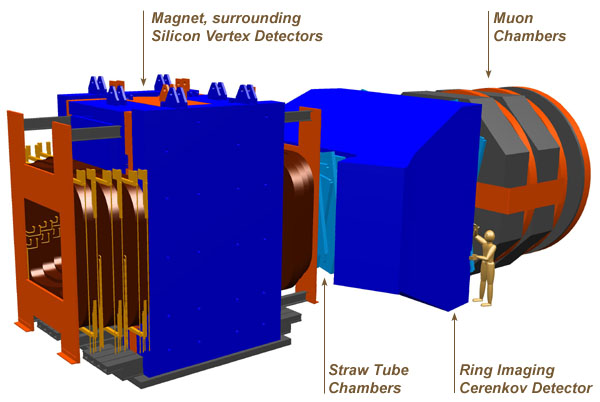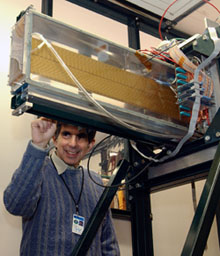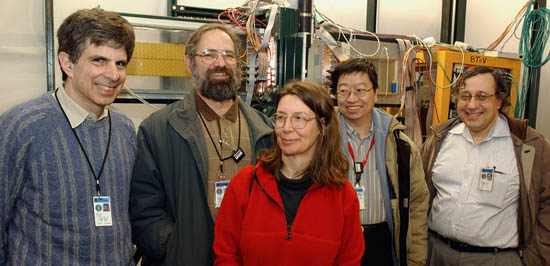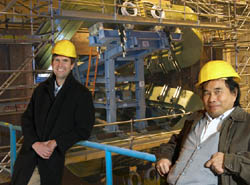 |
|
Critical Decision: BTeV gets DOE
approval by Kurt Riesselmann Scientists of the BTeV experiment at Fermilab will be busy for years to come. At the end of February the Director of the Department of Energy's Office of Science, Ray Orbach, gave Fermilab's B Physics at the Tevatron experiment the first DOE stamp of approval. The decision, referred to as Critical Decision Zero (CD-0), designates the project as necessary to accomplish DOE's mission. It allows Fermilab and the BTeV collaboration to develop a conceptual design report and to submit a budget request. Three additional approvals (CD-1, 2, and 3) with regard to technology, cost and schedule are required before construction can begin.
"We've had a really powerful and effective R&D program, supported by the Department of Energy, the National Science Foundation and Fermilab," said Sheldon Stone, professor at Syracuse University and cospokesperson of the BTeV collaboration of 170 scientists from six countries. "The big step was getting the DOE behind the project." Prior to the CD-0 approval, the BTeV experiment had received positive evaluations from several review committees, including Fermilab's Physics Advisory Committee and the U.S. Particle Physics Project Prioritization Panel. At the end of 2003, DOE's Office of Science listed the BTeV experiment in its 20-year strategic plan for future scientific facilities, ranking the experiment in the top one third and giving it near-term priority. The BTeV experiment will use Fermilab's Tevatron collider to make precision observations of particle processes that will provide hints at the evolution of the early universe. Scientists will use a system of high-tech detectors to analyze the decay of composite particles containing bottom quarks, which were first discovered at Fermilab in 1977. Scientists believe that the composites, known as B mesons, hold the key to understanding CP violation, a phenomenon that may explain why the universe contains more matter than antimatter and how the universe evolved from its simple initial state to the complex patterns we see today.
"If the universe started out symmetrically, then why is all the antimatter gone? B physics is one of the few areas in particle physics where matter and antimatter do not behave identically," explained Stone. "The bottom quark and the bottom antiquark do not decay in identical manners. Yet our present particle theory is flawed as it doesn't explain the abundance of matter in our universe." BTeV will also look for rare B decays, subatomic processes that may contradict theoretical predictions. Such processes could indicate new subatomic particle behavior, perhaps caused by yet-undiscovered particles or a new type of subatomic force. The first-step approval of the BTeV experiment was welcome news for physicists working on the LHCb experiment, under construction at the European particle physics laboratory CERN since 2002. "We congratulate our colleagues at BTeV," said LHCb spokesperson Tatsuya Nakada, of the Swiss Federal Institute of Technology, Lausanne, and CERN. "It is encouraging to see the confirmation of the importance of B physics." LHCb and BTeV are the future generation of B physics experiments, designed to study the elusive mechanism behind the matter-antimatter asymmetry and to look for new physics phenomena. In the last ten years physics laboratories around the world have embarked on an ambitious experimental B physics program. In the late 1990s the accelerator laboratories SLAC in California and KEK in Japan built B factories: electron-positron colliders dedicated to the production of B mesons. The machines have produced collisions since 2000, and currently they are operating at their best performance ever. The colliders, which are limited in the types of B mesons that can be produced, have enabled the corresponding experiments, BaBaR and Belle, to collect a wealth of information.
LHCb and BTeV will rely on colliders that produce proton-proton and proton-antiproton collisions, respectively. Such collisions produce more types of B mesons, allowing scientists to study CP violation in many different processes. In addition, both experiments will record even more B decays per year than current experiments, improving the chances of observing very rare decays. "We will extend the results of the B factories," said Roger Forty, LHCb collaborator, CERN. "We will have higher statistics, and we will study B decays at higher energies allowing different types of B particles to be investigated. The B factories have yielded signatures that are not in full agreement with the Standard Model of particle interactions. At the same time, the results of BaBar and Belle are not in full agreement with each other either. Together with BTeV we will clarify the situation." Both the BTeV and LHCb detectors are highly specialized tools designed with one goal in mind: to capture B mesons that leave the collision point in the forward direction. Unlike the BaBar and Belle detectors, which completely surround the collision point, the next-generation B detectors are designed only to record particles leaving the collision in the forward direction, close to the beam pipe. "You couldn't do B physics in the forward direction in the 80s. The technology just wasn't up to it," said Fermilab's Joel Butler, cospokesperson for the BTeV experiment. "The CDF and DZero experiments (at Fermilab) focus on measuring transverse B particles. But technology has made a lot of progress. We are doing B physics in the forward direction because the Bs are faster. They travel a lot farther before they decay. That makes it easier to separate them from other particle events." To record the forward Bs, BTeV scientists have designed radiation-tolerant decay vertex detectors that can be positioned only six millimeters from the collision point. Parts of the vertex detector are located inside the beam pipe, closer to the collider beams than in any other collider experiment. To the outsider, the BTeV and LHCb detectors are rather similar. Both experiments follow the same good strategy, and their scientists regularly share their expertise with each other at workshops and conferences. In the details, however, the technologies are different. The BTeV experiment will feature some alternative technology choices compared to the LHCb experiment, which already was approved in 1998. "Our whole trigger and data acquisition system is a very big advance over what LHCb can do," said BTeV's Stone. "In addition, we use silicon pixel detectors. They provide better precision tracking than strip detectors."
For the LHCb collaboration it is too late to make major design changes. Construction of the large dipole magnet, a core component of the detector, is close to completion. Other components, such as calorimeter modules produced in Moscow, already have arrived at CERN as well. Yet there is room for final tuning. "We've been inspired by the BTeV strategy for the trigger system," Nakada mentioned as an example. "This led to a modification of the LHCb trigger to improve its efficiency. Also, we've just finished the re-optimization of our systems for material budget reduction." In the meantime the BTeV collaboration has been preparing for the next couple of DOE reviews. The CD-1 review of technology, cost and schedule will be in April. If approved, scientists expect the CD-2 and CD-3 reviews to happen soon thereafter. "We're confident that we will surpass all of these hurdles," said Butler. "We'll convince people that we have a great experiment and are ready to move ahead. If everything goes well the experiment will be taking data in 2009."
On the Web:
BTeV Experiment:
LHCb Experiment:
DOE's Facilities for the Future of Science: A 20-year Outlook: |
| last modified 4/7/2004 email Fermilab |
FRLsDFx9eyfrPXgV



